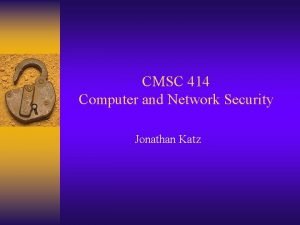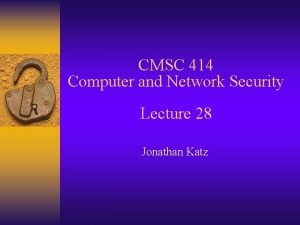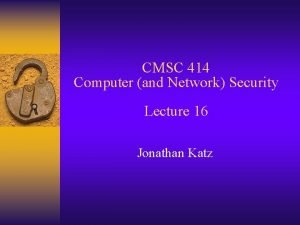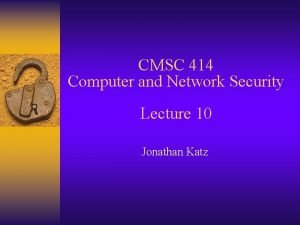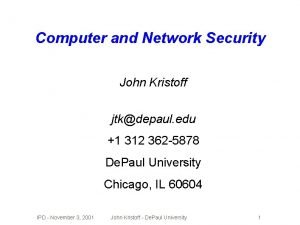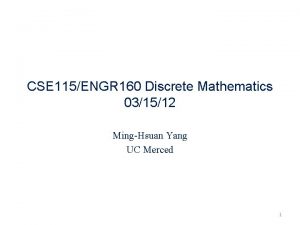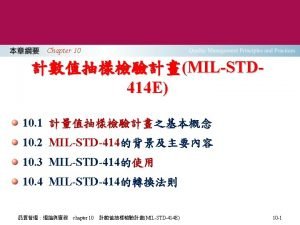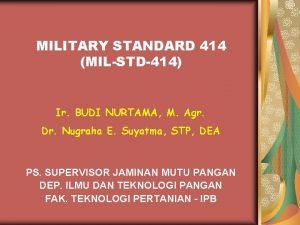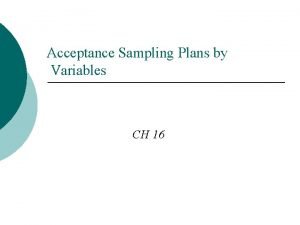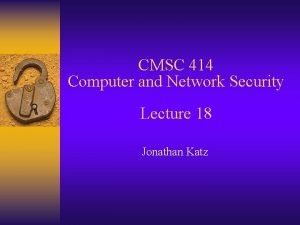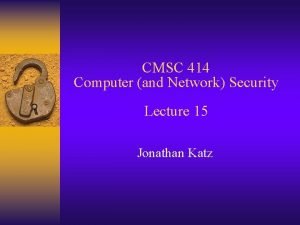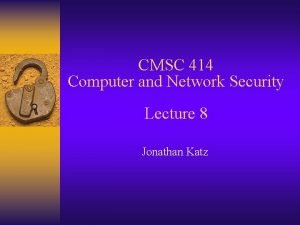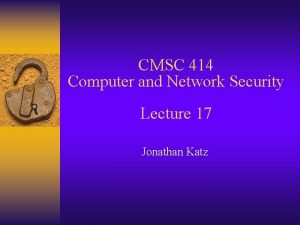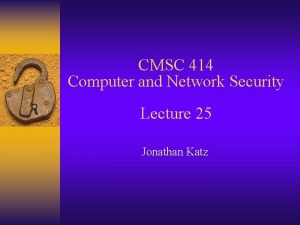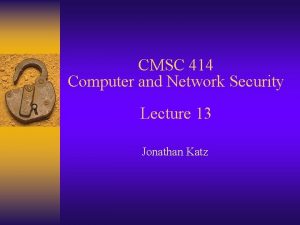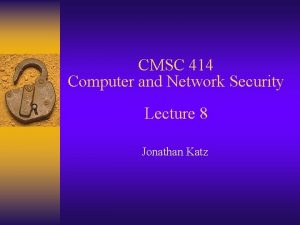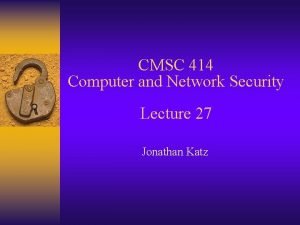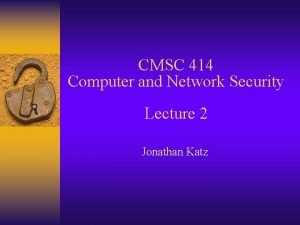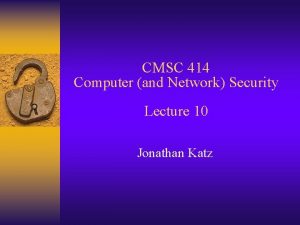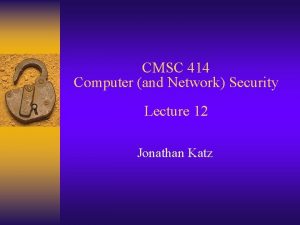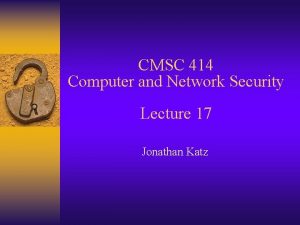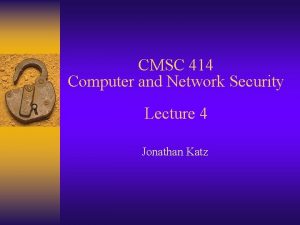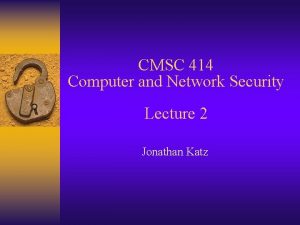CMSC 414 Computer and Network Security Lecture 9



















- Slides: 19

CMSC 414 Computer and Network Security Lecture 9 Jonathan Katz

Midterm exam… ¨ This Thursday ¨ Open notes/book/etc – All you should need are your notes – Printouts of case studies might be helpful, but not necessary if you have read/understand them

(HW 2 is out)

Security policy ¨ Security policy classifies system states as “secure” or “insecure” – “System state” may potentially include everything… ¨ A secure system starts in a “secure” state and cannot enter an “insecure” state – “Breach of security” occurs when a system enters an “insecure” state

Security mechanism ¨ A security mechanism enforces (part of) the security policy – Includes procedural/operational controls, not just technical controls • E. g. , who may enter the room in which backup tapes are stored • How new accounts are established

System security at the OS level ¨ Crypto is not the only possible mechanism ¨ Motivating example: secrecy of user files – In general, these files are not encrypted – Instead, access to users’ files is controlled by the OS • This offers protection against other users… • …but does not offer protection if the hard drive is physically compromised, or against a sys admin who may have the ability to read all files

Other issues… ¨ File confidentiality is not the only issue – Confidentiality of actions or temporary data – Should allow file sharing when called for – Integrity of system-wide files – Resource sharing (cycles, bandwidth, disk space, …) ¨ These various requirements stem from the fact that modern OSs use multiprogramming – One user’s actions can affect other users

Some terminology ¨ Protected entities: “objects” O ¨ Active objects: “subjects” S (i. e. , users/processes) – Note that subjects are also objects ¨ Subjects/objects can be: – Files – Processes – Systems – Functions/variables (within a program) – Database entries – Etc.

Authorization vs. authentication ¨ The issues are orthogonal – Authentication is a means of proving to the system that you are a particular user (or belong to a particular group, etc. ) – Authorization assumes that you have already been properly authenticated, and is concerned with controlling your access to objects ¨ We will discuss authentication later

Some possible approaches ¨ Physical separation – Different systems for different users ¨ Temporal separation – Users run processes at different times – Both of the above use resources poorly ¨ Logical separation ¨ Cryptographic separation

Logical separation… ¨ Complete isolation – E. g. , all users/processes unaware of any others ¨ “All or nothing” – Either a file is completely public or private – Or, users either aware of each other or not ¨ Access control – More fine-grained; determines access at the subject/object level

Continued… ¨ Dynamic access control (capabilities) – Access may depend on the context, or on more complicated conditions ¨ Limited use – Access to object is limited: e. g. , read but not modify ¨ Level of granularity is important – Finer granularity more “secure” but more difficult to implement

Memory protection ¨ “Fence”: restricts access to portions of memory ¨ E. g. , predefined memory address where OS resides; users disallowed from modifying – Can be enforced at the hardware level – More difficult if OS is supposed to be “modifiable”; e. g. , if systems must support multiple OSs

Continued… ¨ Variation is to have a “fence register” which stores the address of the protected portion of memory – Protected portion can dynamically change – More opportunity for security breaches…

Continued… ¨ Fence registers have other advantages – Allow easy “relocation” by simple addition (in hardware) – Can have two such registers: base register and bounds register – Extends to allow separation of memory space for multiple users – Context switching also updates base/bounds registers

Further extensions ¨ Note that this only protects users from each other – Does not prevent error within one user’s memory space ¨ Can additional base/bounds registers – I. e. , one set for instructions and one for data – In theory, can extend this; in practice it is difficult to have more than two sets per user

Tagged architecture ¨ Base/bounds registers offer very course- grained protection – Also, have the restriction that different sections of memory space must be contiguous ¨ Possible to improve this by tagging every, e. g. , word of memory via protected op. – Can be wasteful of bits… – Requires changes at the hardware level

Segmentation ¨ Program components divided into logical segment (e. g. , code of a single procedure) ¨ Each segment has a unique name; items within segment addressed by (name, offset) ¨ Each segment stored anywhere in memory – OS handles mapping; transparent to user – Can implement protection for each segment – OS controls which programs have which entries in their segment address tables

Drawbacks of segmentation? ¨ Users can guess memory locations ¨ Users can generate (name, offset) where the offset is larger than the segment size – Can imagine fixing this, but this is inefficient ¨ Memory fragmentation ¨ Address table lookup can be slow
 Cmsc414 umd
Cmsc414 umd Cmsc 414
Cmsc 414 Cmsc 414
Cmsc 414 Cmsc 414
Cmsc 414 Computer security 161 cryptocurrency lecture
Computer security 161 cryptocurrency lecture Wireless security in cryptography
Wireless security in cryptography Private securty
Private securty Computer and network security
Computer and network security The osi security architecture
The osi security architecture Security guide to network security fundamentals
Security guide to network security fundamentals Electronic mail security in network security
Electronic mail security in network security Security guide to network security fundamentals
Security guide to network security fundamentals Security guide to network security fundamentals
Security guide to network security fundamentals 01:640:244 lecture notes - lecture 15: plat, idah, farad
01:640:244 lecture notes - lecture 15: plat, idah, farad Computer & network security
Computer & network security Gcd of 414 and 662
Gcd of 414 and 662 Network topologies
Network topologies Mil-std-414
Mil-std-414 Mil-std-414
Mil-std-414 Mil-std 414
Mil-std 414
